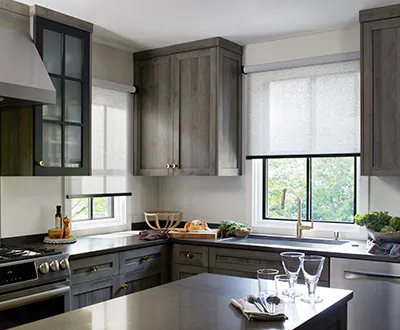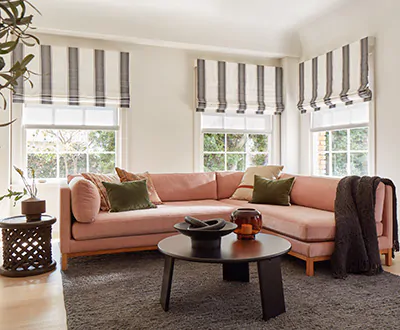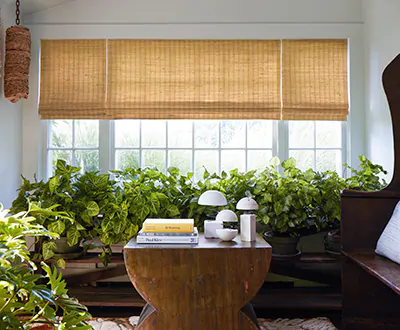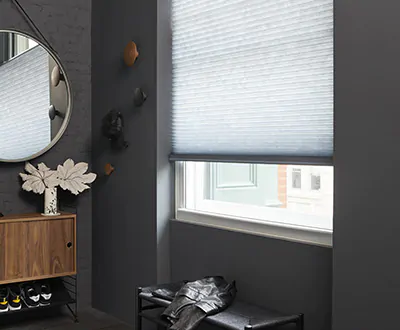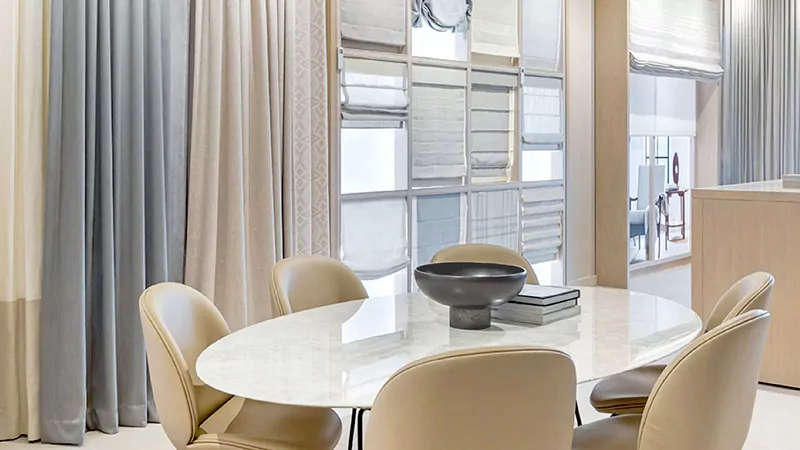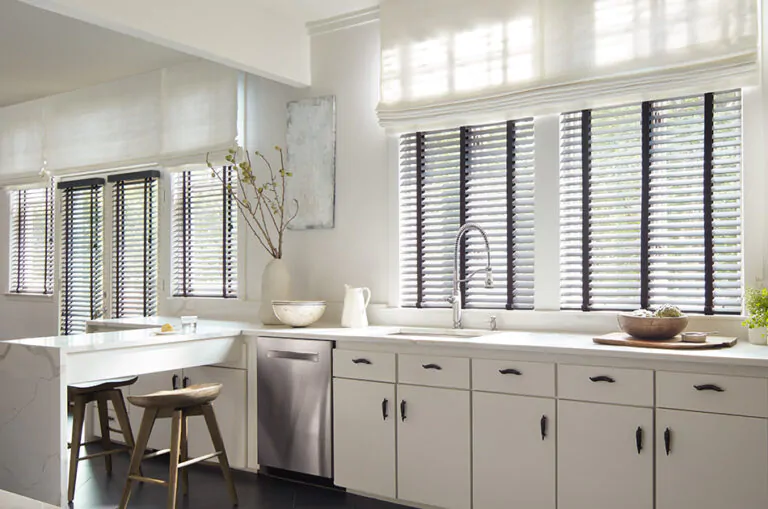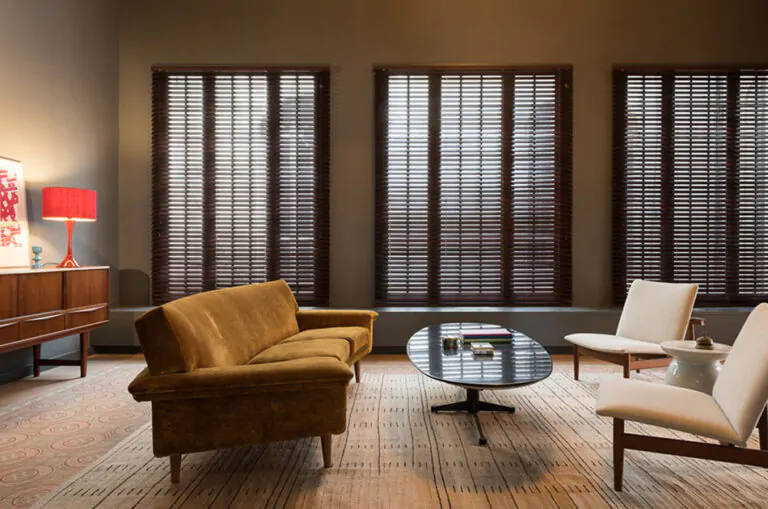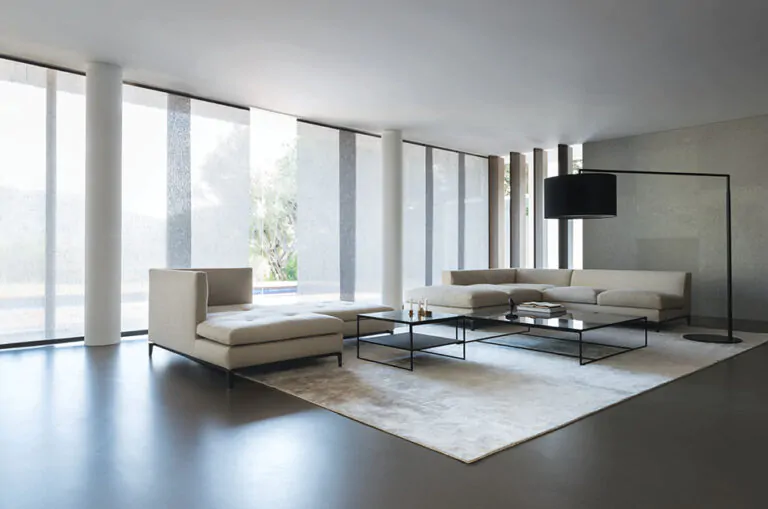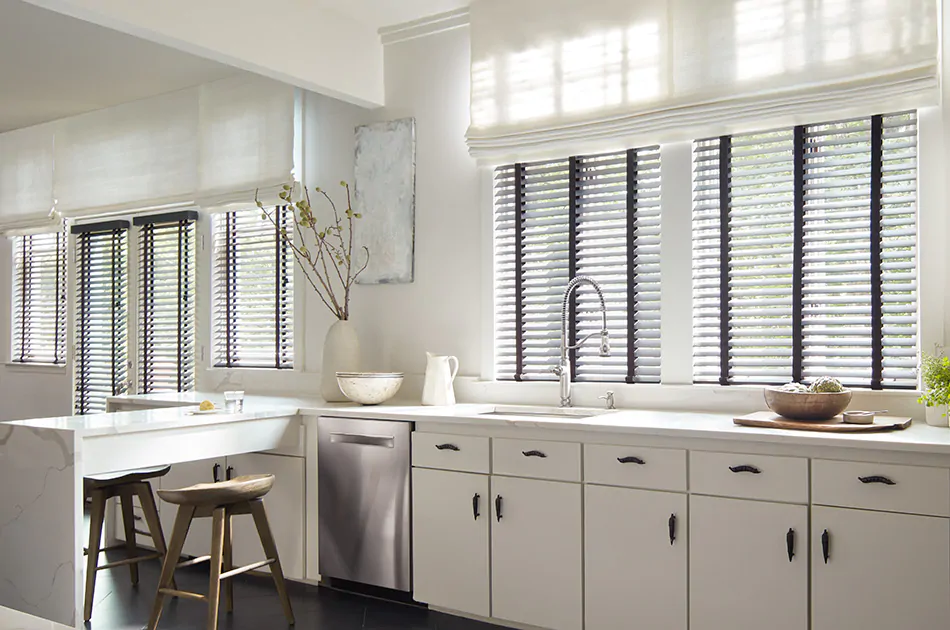
Blinds vs Shades: Differences & How to Choose
Comparing blinds vs shades for new window treatments in your home? Blinds and shades share a lot of similarities, but there are also key differences that could make one better than the other for your specific application. Determining which is the best choice for your home depends on several factors, all of which come down to your personal needs and wants.
To help you decide between shades vs blinds, first learn exactly what each is. Then, dive into differences based on several topics to help you better understand your options.
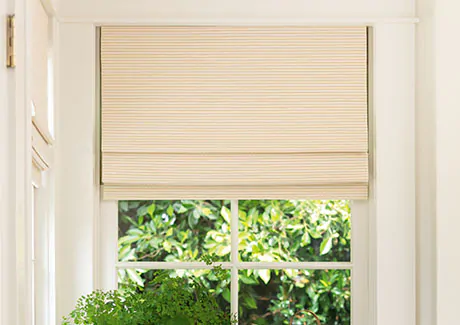
What Are Shades?
Shades are single-panel window treatments typically made from soft fabrics as in Roman Shades, woven fibers as in Woven Wood Shades, or hard textiles as in Roller Shades. Shades come in many different aesthetic styles and functionalities.
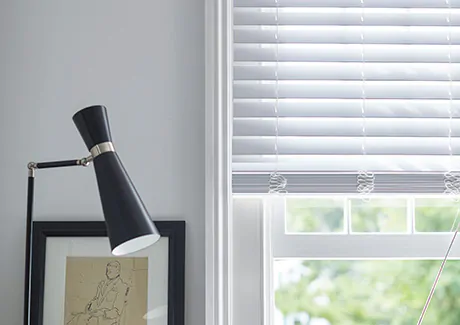
What Are Blinds?
Blinds are window treatments that most commonly have horizontal slats made from a hard material like wood, faux wood or metal. Blinds can also feature vertical slats made with panels of hard textiles, similar to the material used for Roller Shades.
Considering Other Window Treatments?
Learn the differences between all the main types of window coverings including Drapery, Shades and Blinds in our comprehensive guide. READ THE GUIDE
What Is the Difference Between Blinds & Shades?
To fully understand the differences between shades vs blinds, you need to consider them from several perspectives. That’s why we’ve outlined the differences between blinds vs shades through the lens of the following topics to help you make the best choice for your home.
In this article
Aesthetics
When it comes to aesthetics, comparing blinds vs shades reveals significant differences. This is mostly due to the distinct appearances of the two types of window treatments. Plus, within the larger category of shades, there are varying aesthetics between the many types of shades. Explore blinds vs shades in terms of aesthetics to discover which better suits your sense of style.
Blinds Aesthetics
When comparing blinds vs shades in terms of aesthetics, Blinds have a decidedly more utilitarian appearance. With their slatted design, you gain excellent light and privacy control, as you can tilt the slats or lift and lower the blinds for varying degrees of light exposure and visibility. The slats of blinds also offer a defined linear aesthetic that can suit a wide range of styles from traditional to modern. Plus, depending on the material you choose for your blinds, you can customize your look further with specific colors, finishes and even decorative tape.
Wood Blinds feature different wood grains and finishes, from exotic wood aesthetics with lots of color and grain variation to more chic painted wood looks with a more minimalist look. The real wood look of these blinds can suit a range of styles depending on the color and finish you choose. More intricate, exotic wood aesthetics are geared toward traditional-style homes, but can also suit a mid-century modern or Scandinavian-inspired home that champions natural materials.
Metal Blinds deliver a more distinctly modern appearance and offer colors from metallic silver and gold to more muted white and black. The metallic sheen of Metal Blinds is best suited to urban, modern and industrial spaces.
Shades Aesthetics
Between shades vs blinds, shades offer greater design versatility thanks to the many types of shades available which offer varying aesthetics. From sleek, modern looks to luxurious, elegant aesthetics, there’s a shade design to suit your style.
The Shade Store Recommendation
Between the aesthetics of blinds vs shades, the best choice comes down to your personal preference and how you want your window treatments to transform your room. If you’re looking for simple functionality and a warm wood tone or metallic sheen, opt for Blinds. If you’d rather have lots of design versatility to create your own look, opt for the style of Shade that best suits your aesthetic.
Ease of Use
Ease of use refers to the effort it takes to adjust your window treatments. Between blinds vs shades, ease of use primarily varies between different control types. However, in the case of shades, it can also vary based on the type of shade you choose, as some styles are designed to be primarily decorative vs functional.
Blinds Ease of Use
Whether you choose a cordless system or motorization, your blinds are straightforward and easy to operate.
- For cordless blinds, simply grab the bottom bar of your blinds and pull down or push up to adjust the height. For slat control, twist the wand to adjust the slats.
- For motorized blinds, the motor only controls the tilt of the slats. And you can adjust the tilt with a remote, an app on your phone or tablet or the sound of your voice when paired with a home automation system. You won’t be able to lift or lower your blinds.
Shades Ease of Use
Between blinds vs shades, most shade styles are also easy to use, and it’s often a matter of adjusting them up or down with your chosen control type. However, a couple of Roman Shade styles, like Relaxed and Tulip Roman Shades are designed specifically to be decorative and are not easy to lift and lower on a daily basis.
Functional, Easy-to-Use Shades
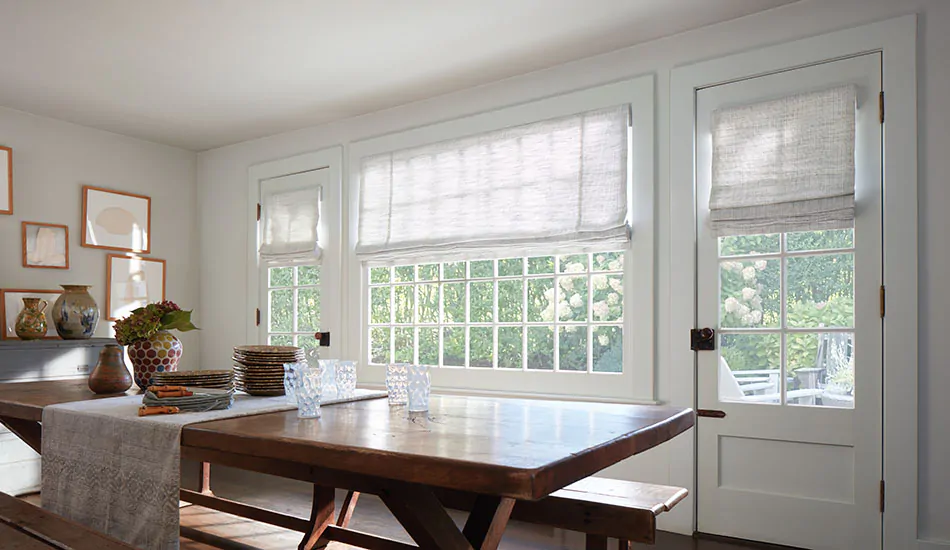
In comparing shades vs blinds, most types of shades are functional and easy to use, sharing some of the same control types as blinds.
Depending on the type of shade you choose, you’ll have several control type options:
- Continuous loop: To adjust shades with a continuous loop, pull the front side of the looped chain down to lift the shade and lift the chain up to lower the shade. You can also lower the shade by pulling down on the side of the chain closer to the window.
- Cordless: Grab the bottom bar of Solar or Roller Shades, or the ring sewn to the back of your Roman Shades or Woven Wood Shades, and pull the shade slightly down and toward you to release the lock. Then pull the shade down further to lower it or allow the shade to rise. To lock it back into place, simply push the bottom bar or ring back toward the window. To adjust Cellular Shades, simply pull the bottom bar up or down, just like cordless blinds.
- Motorized: The motor for motorized shades controls the height with the press of a button on a remote, through an app on your phone or tablet, or with the sound of your voice when paired with a home automation system.
Remember, different types of shades will have different control types available, so be sure to choose the type of shade that gives you the control type you’d prefer.
Decorative, Non-Functional Shades
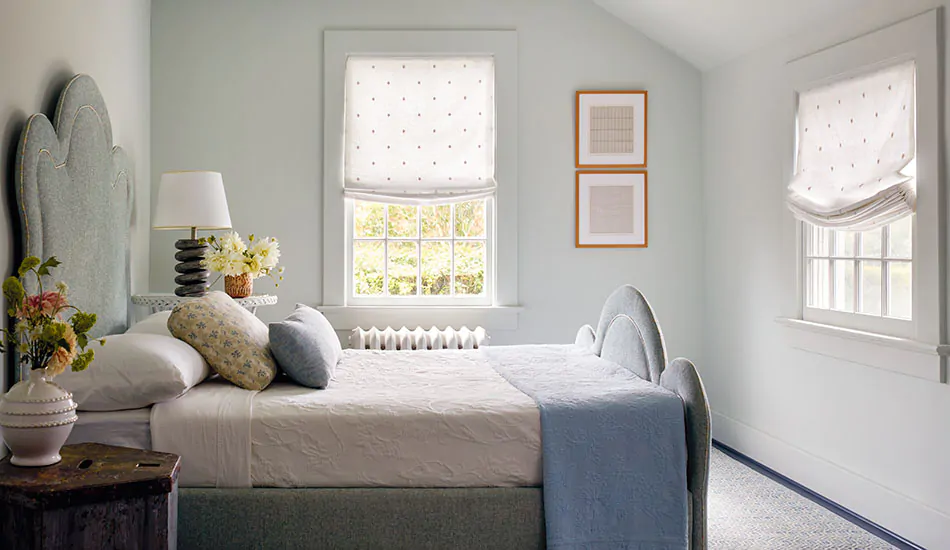
While both Tulip and Relaxed Roman Shades come continuous loop control, they are not suitable for everyday use. This is because the loose folds of these types of shades will require dressing every time you lift or lower the shade in order for it to look intentional and attractive. That’s why it’s best to adjust these shades once and leave them as they are for decoration rather than functionality.
The Shade Store Recommendation
When comparing blinds vs shades in terms of ease of use, both offer simple, fuss-free control types, including motorization. Choosing the right one will depend on your specific needs. If you require everyday adjustment, choose cordless blinds or a type of functional shade. If you’d prefer to adjust your window treatments only once in a great while, more decorative styles like Relaxed and Tulip Roman Shades are an option for you.
Light & Privacy Control
Light and privacy control are key components of your window treatments, and it’s important you get the right level of both. Between blinds vs shades, light and privacy control varies considerably, with shades offering many more options with light-filtering materials and linings.
Blinds Light & Privacy Control
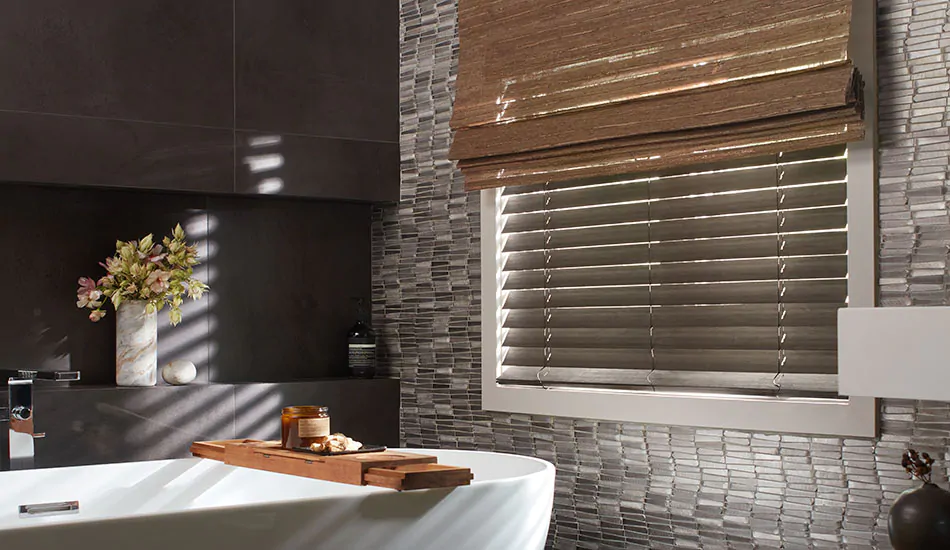
In comparing shades vs blinds, blinds offer great light and privacy control thanks to their easily tiltable slats, and with cordless control, you can also easily lift and lower your blinds. Tilting the slats to be level can give you a light filtering effect and will still allow you to maintain your view. Tilting the slats all the way up or down can block the view and give you excellent privacy and a good room darkening effect. However, some light may still seep through the braided ladder cords in between the slats. For the best room darkening effect with blinds, add decorative tape, which covers the cords and gives you a bit more coverage. However, be aware that adding tape means you won’t be able to lift or lower your blinds, regardless of control type chosen; you’ll only be able to tilt the slats.
Shades Light & Privacy Control
Between blinds vs shades in terms of light and privacy control, shades only offer one mode of operation: lifting and lowering the shade. However, shades make up for it with their many light-filtering materials and linings that range from unlined sheers to blackout materials and lining. When thinking about privacy and light control, remember that certain shades, like Tulip and Relaxed Roman Shades, are not ideal for everyday use and so are not the best choice for excellent privacy and light control.
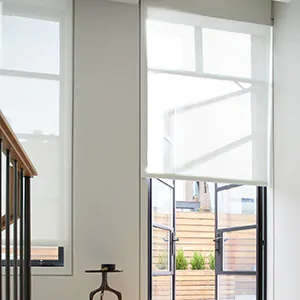
Light-Filtering Materials with Little Privacy
For a light filtering effect that still gives you some level of privacy, consider:
- Solar Shades
- Sheer Roller Shades
- Unlined, sheer Roman Shades
- Unlined Woven Wood Shades
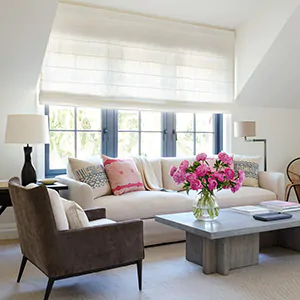
Light Filtering with Good Privacy
For some light filtering through your window for a soft glow, while providing excellent privacy, consider:
- Light Filtering Roller Shades
- Light Filtering Cellular Shades
- Privacy lined Roman Shades
- Privacy lined Woven Wood Shades
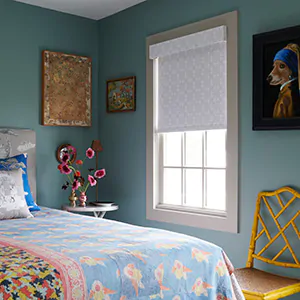
Blackout Materials & Lining
For the best in both privacy and light blocking ability, consider:
- Blackout Roller Shades
- Blackout Cellular Shades
- Blackout lined Roman Shades
- Blackout lined Woven Wood Shades
The SHAde Store Recommendation
Between shades vs blinds, for the very best privacy and blackout effect, it’s best to choose Shades with a blackout material or lining. For sunny rooms where you want to soften the light while still enjoying some privacy, choose Shades with a light filtering material or lining. Blinds can also be a good choice for rooms where you want easy light and privacy control as their tiltable slats make control a breeze.
Insulation
The insulation your window treatments provide can actually help regulate your interior temperatures and even cut back on your energy bills. But not all window treatments provide the same level of insulation. In comparing blinds vs shades, it’s clear some types of shades can really make a difference in terms of insulation.
Blinds Insulation
All blinds can block light coming into your home to prevent heat build-up, and Wood Blinds can also absorb a bit of moisture and some hot and cold air. However, overall, blinds are not ideal for providing insulation. Wood slats can only absorb so much moisture and air responsible for creating a chill or heat in the room, and Faux Wood and Metal Blinds absorb even less.
Shades Insulation
Between blinds vs shades, many types of shades are better at insulating your home than blinds. For the very best insulation, stick to these types of shades:
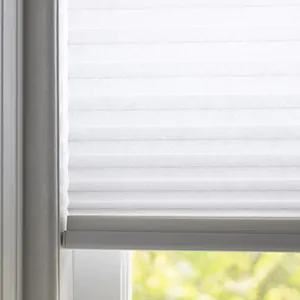
Cellular Shades
For the best all-around insulation, choose Cellular Shades. Their unique honeycomb design traps hot and cold air alike, helping to regulate your interior temperatures.
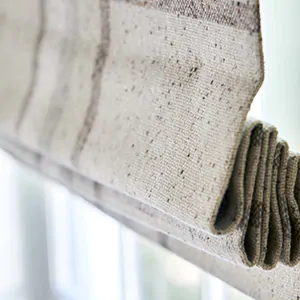
Functional Roman Shades with Lining
When lined with privacy or blackout lining, Roman Shades can provide excellent insulation for your windows as the extra fabric helps to absorb hot and cold air.
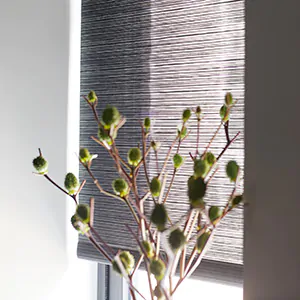
Solar Shades
Designed to block UV rays, the source of heat from the sun, without blocking light, Solar Shades allow you to maintain the natural light in your room while cutting back on heat build-up.
The Shade Store Recommendation
Between blinds vs shades, Shades offer far better insulation than Blinds. For your most drafty rooms, choose Cellular Shades or lined Roman Shades. For your sunny rooms, opt for Solar Shades to maintain the warm glow of natural light while preventing too much heat buildup.
Durability
In comparing blinds vs shades, durability varies based on the material of your window treatments. Different materials have different properties that make them more or less resilient to everyday use as well as environmental factors like the presence of moisture or humidity.
Blinds Durability
All types of blinds, Wood, Metal and Faux Wood, are very durable, with Faux Wood and Metal also being resistant to moisture and humidity.
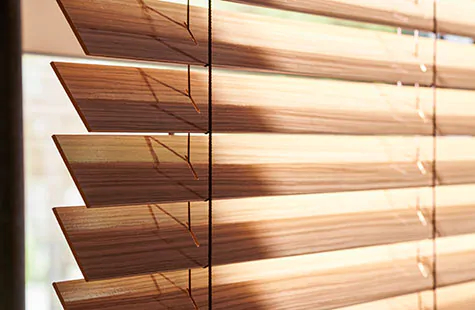
Wood Blinds
Wood Blinds are typically made from American Basswood, a hardwood that’s ideal for blinds thanks to its light weight and fine, uniform texture.
However, wood is vulnerable to moisture and humidity, which can cause the wood to warp, so wood blinds are not an ideal choice for bathrooms or basements.
Metal & Faux Wood Blinds
Metal Blinds are made from aluminum, while Faux Wood Blinds are made from a mix of synthetic and wood fibers. Both are very durable and long-lasting, and are also resistant to moisture, making them better suited to rooms with moisture and humidity like bathrooms.
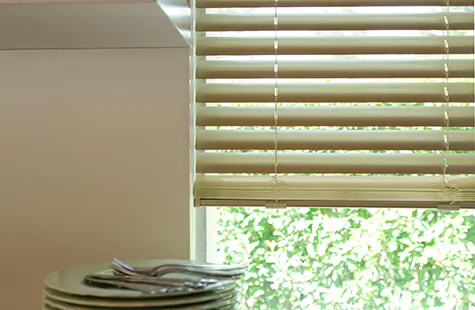
Shades Durability
The durability of your shades will depend on the material of your shades — and different types of shades have different material options.
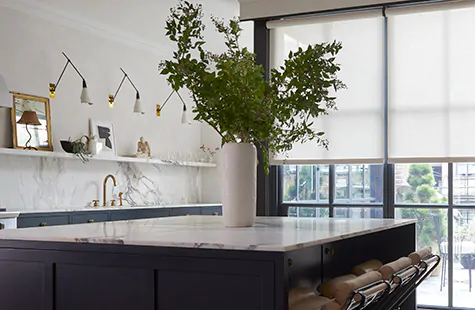
Solar & Roller Shades
Solar and Roller Shades are both made from synthetic fibers like polyester, vinyl, fiberglass and acrylic. These materials are highly durable, resistant to moisture and stains, and are often very easy to clean.
roman Shades
Roman Shades come in a wide range of materials, from synthetic fibers like polyester and acrylic to natural weaves like linen, cotton and wool. While synthetic fibers are often very durable, natural materials can be more vulnerable to elements like moisture and stains. Therefore, for humid or active rooms like bathrooms, kitchens, or children’s rooms, it’s best to choose a more durable synthetic material.
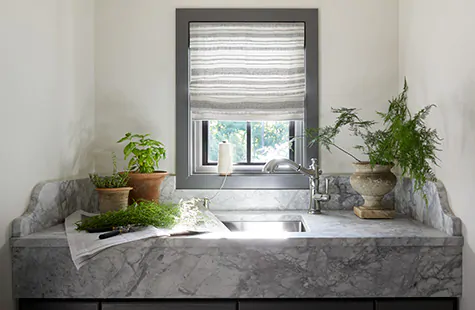
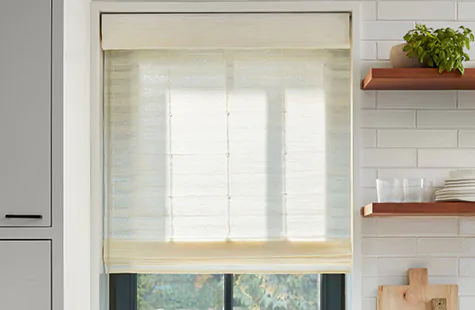
Woven Wood Shades
Woven Wood Shades are typically made from natural fibers like bamboo, grasses and reeds. While these woven fibers are surprisingly resilient, they can deteriorate over time in the sunlight and are vulnerable to moisture. To protect these shades, it’s often best to line them with privacy or blackout lining and use them in rooms with low moisture and humidity.
Cellular Shades
The soft polyester fabric of Cellular Shades can be vulnerable to tears and moisture. But when well cared for, and used in rooms without much humidity or moisture, Cellular Shades offer great durability when it comes to daily wear and tear.
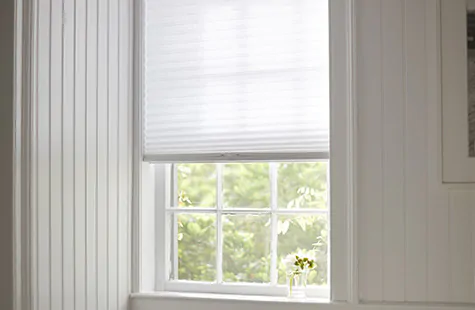
The Shade Store Recommendation
In comparing shades vs blinds in terms of durability, Blinds give you worry-free durability and easy-to-clean materials no matter your selection. Shades made from synthetic materials like Solar and Roller Shades can also be a good choice for more active or moisture-prone rooms.
Upfront Costs
The upfront costs of blinds vs shades only includes the cost of the materials you’ll need for installation. Total project costs will depend on more factors such as if you’ll hire professionals for installation or DIY the job yourself. For comparison between shades vs blinds, we’ll only look at upfront material cost.
Blinds Cost
The cost of blinds vs shades really depends on several factors like the material and control type you choose. While aluminum Metal Blinds are very affordable compared to most types of shades, exotic Wood Blinds will naturally be more expensive. In the same way, cordless control or no lift, only tilt control will be more affordable than motorization.
Shades Cost
Between all the different types of shades, material choices, and control types, shades can vary significantly when it comes to cost. For the most affordable options, go for Solar Shades, Roller Shades and Cellular Shades. Roman Shades and Woven Wood Shades can start getting pricier based on the material and style of shade chosen, with Pleated Roman Shades often being the most expensive simply because of the amount of material used to create the luscious folds of fabric. Additionally, just like blinds, the control type you choose will also affect cost, with manual options being more affordable than motorization.
The Shade Store Recommendation
In comparing shades vs blinds, it’s clear that both offer affordable options in terms of upfront costs. Choosing between your options will depend on your individual budget, needs and wants.
Installation
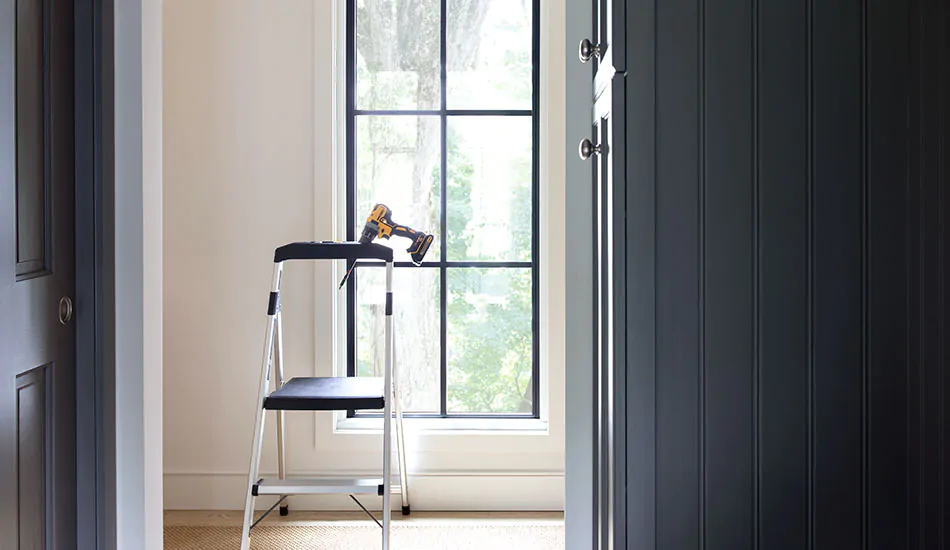
When it comes to installation, comparing blinds vs shades comes down to looking at the amount of time and effort it takes to mount them and get them functional. In general, both blinds and shades share the same basic installation instructions:
- Step 1: Gather tools. You’ll typically need a stepladder, pencil, tape measure, level, drill and screwdriver, but check your blinds’ or shades’ specific install instructions for an exact list.
- Step 2: Decide whether you’ll inside or outside mount your blinds or shades, which means deciding whether to place them inside the window frame (inside-mount) or outside the window frame on the wall (outside-mount).
- Step 3: Measure appropriately based on your mount choice and mark where the mounting brackets and headboard, or tube, in the case of Roller and Solar Shades, will go.
- Step 4: Install the brackets in the right place with the appropriate tools as indicated in the installation guide for your chosen blinds and then attach the headrail or tube for Roller and Solar Shades.
Blinds Installation
Between blinds vs shades, all types of blinds have essentially the same installation process for a straightforward experience, no matter your choice of blinds material.
Shades Installation
Shade installation varies between the different styles, but they all generally have the same basic steps as listed above. The main difference in shade installation includes Roller and Solar Shades, which feature a tube to attach to the brackets vs a headrail.
The Shade Store Recommendation
When comparing shades vs blinds, both offer similar best practices for installation, so the time and effort is relatively even. Of course, installation difficulty will ultimately depend on your specific skills and comfort level.
Cleaning & Maintenance
Cleaning and maintenance, like durability, varies based on the material chosen for your window treatment.
Blinds Cleaning & Maintenance
Between shades vs blinds, maintenance for blinds is very simple. Wipe the slats, whether wood, faux wood or metal, with a damp cloth as needed to remove dirt and dust. Make sure to not leave any moisture lingering on your blinds by wiping again with a dry cloth to remove excess moisture.
Shades Cleaning & Maintenance
Cleaning and maintaining your shades will depend on the type of material your shade is made of. All materials can be vacuumed to remove surface dust and dirt, but for embedded dirt or stains, more involved measures may need to be taken.
For Solar and Roller Shades, thanks to their synthetic material, you can likely clean them using Mr. Clean Magic Erasure which can remove many spots and stains.
For Roman Shades, Woven Wood Shades and Cellular Shades, it’s often best to rely on a local window treatment cleaning specialist who can treat your shade onsite, without taking it down.
If you have Sunbrella material for your shade, you can likely clean stains at home. For most liquid spills get as much of the liquid out as you can by blotting with a clean, dry cloth. For oil-based stains, first apply an absorbent like cornstarch, then remove it with a straight edge. Next, spray on a mild cleaning solution of dish soap (like Dawn) and water. Then rinse the fabric thoroughly to remove all soap residue and let it air dry.
The Shade Store Recommendation
In terms of cleaning and maintenance, between blinds vs shades, blinds are the more straightforward option to choose. However, shades made with synthetic material can also be cleaned at home with a little effort.
Now that you have a thorough comparison of blinds vs shades, you have the knowledge you need to get one step closer to making the best decision for your space.
Finalize Your Choice: Blinds vs Shades
After all you’ve learned about the difference between shades vs blinds, you’re ready to explore your options further and finalize your decision. Visit a local showroom to see all your Blinds and Shade options up close. Feel the different textures of material, explore all your color and pattern choices and play with all the functionalities based on widow treatment type and control system. You’ll also find helpful advice from our team of expert Design Consultants who can help answer all your questions and guide you toward the perfect window treatment choice for your home.
